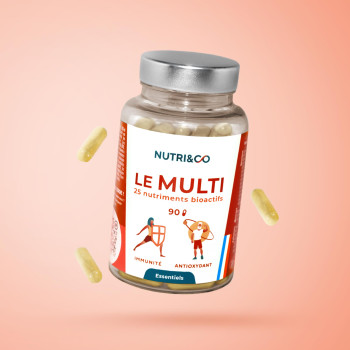
Vitamins and minerals : vital
"Hey You! You're losing your vitamin C! ", was egosilated in 1972 Damo Suzuki, the singer of the mythical group Can. In fact, the vocalist was aware of how valuable this macronutrient is. And for good reason: the body is unable to produce it. Like no other vitamin or mineral. However, these non-caloric molecules - and yes, they do not make you fatten - are essential to the functioning of our body, and therefore to life! Vitamins and minerals play a key role in our immune functions (1), for tone and energy production (2), and are an excellent antioxidant (3). The list of their benefits does not stop there: they are useful for growth (4) and bone health (5), maintaining a good heart rate (6), cognitive functions (7), and protein synthesis.
Where to find vitamins and minerals ?
Since the body does not make them, it will be necessary to watch over its diet. Not easy, unless you have a time machine and go shopping... at the end of the 60s at the latest. There is no hippie trip here, but a sad observation: in fifty years, the progress of mass agriculture has resulted in an equally massive decline in the quality of nutritional intake. The cause: seeds selected for their yields, to the detriment of the rest. Judging by this, bananas have lost 90% of their vitamin A, an apple contains a hundred times less vitamin C, while potatoes have lost 57% of their B vitamins. Finally, overcooking our vegetables ends up destroying the few surviving nutrients. The result: five fruits and vegetables per day are not enough to get your daily intake of vitamins and minerals... unless you choose the larger ones, since you will have to eat 1,25 kg. For example, while an orange from a not so long ago provided almost all of our daily vitamin A, we would have to swallow twenty-one of them today ! (8) In this context, it is difficult to avoid deficiencies. This observation prompts leading scientists, such as Walter Willet, head of Harvard's Nutrition Department, to declare that "the food pyramid must include the daily intake of multivitamins"; Linus Pauling, Nobel Prize winner in chemistry, does not hesitate to certify that "each condition can be traced back to a mineral deficiency. "No wonder, then, that 81% of American doctors take a multivitamin every day(9).

Which multivitamins to choose ?
Natural or synthetic molecules, optimized or broad-spectrum formulas, the supply of multivitamins is abundant. But what are the real quality criteria? First, choose ready-to-use vitamins, such as natural vitamin E or B9 in the form of folates. Then, favour high absorption minerals (beware of inorganic salts of the oxide type), and avoid pro-oxidant nutrients Iron, copper and manganese become so in high doses. Also, choose a megadose specific to D3 Recent studies show that our needs here are actually much higher than the recommended nutritional values . Moreover, the ANSES has just increased the recommended daily doses (10) from 400 IU to 1,000 IU. Finally, be satisfied with the essentials Contrary to popular belief, it is not necessary, for example, to to supplement with calcium. At this stage, you are probably wondering about the origin of vitamins: natural or synthetic ? It doesn't matter, as long as you use a bioactive form (bio-identical). The advantage of synthetic nutrients is double : high concentration and control of pollutants.
Our Multivitamins, the concentrate of the best
Aware of all these imperatives, we have therefore concocted for you, after a year of research, a Multi that combines the essential: 27 bio-active nutrients and no pro-oxidant minerals. Detail review :
- Bioactive vitamins : P'-5-P (B6), Quatrefolic® folates (B9), methylcobalamin (B12) or vitamins A, E and D3 in plant form
- High-grade and highly absorbent minerals in particular with our new liposomal magnesium (link Article Mag)
- The necessary cofactors : 4 carotenoids, 3 bioflavanoïdes, Coenzymes Q10, N-acetlylcysteine and Alfa-Lipoic acid.
- Not to mention a specific dosage for vegetable vitamin D3: 1,000 IU
The icing on the cake, by going back to the source and limiting the intermediaries, our Multi amounts to 22.90 € consumer price, well below the second generation multi-compléments, sold at an average of 30 €.

1. Patricia T. Alpert, « The Role of Vitamins and Minerals on the Immune System », Home Health Care Management & Practice, juin 2017, pp. 199-202 ; Silvia Maggini, Adeline Pierre et Philip C. Calder, « Immune Function and Micronutrient Requirements Change over the Life Course », Nutrients, octobre 2018.
2. Edouard Huskisson, Sylvia Maggini, Martina Ruf, « The Role of Vitamins and Minerals in Energy Metabolism and Well-Being », The Journal of International Medical Research, 2007, pp. 277-289.
3. Élodie Gauche et Christophe Hausswirth. « Stress oxydant, complémentation nutritionnelle en antioxydants et exercice », Movement & Sport Sciences, 2006, pp. 43-66.
4. Susanna Esposito, Alberto Leonardi, Lucia Lanciotti, Marta Cofini, Giulia Muzi et Laura Penta, « Vitamin D and growth hormone in children : a review of the current scientific knowledge », Journal of Translational Medicine, volume 17, 2019.
5. Charles T Price, Joshua R Langford et Frank A Liporace, « Essential Nutrients for Bone Health and a Review of their Availability in the Average North American Diet », The Open Orthopaedic Journal, 2012, pp. 143-149. 6. Mark C. Houston, « Nutraceuticals, Vitamins, Antioxidants, and Minerals in the Prevention and Treatment of Hypertension », Progress in cardiovascular diseases, mai-juin 2005, pp. 396-449.
7. Edouard Huskisson, Sylvia Maggini, Martina Ruf, « The influence of micronutrients on cognitive function and performance », The Journal of International Medical Research, 2007.
8. Amélie Mougey, « Une pomme de 1950 équivaut à 100 pommes d’aujourd’hui », L’Obs, 6 juillet 2015 ; Jeffrey Christian, « Nutrient changes in vegetables and fruits, 1951 to 1999 », CTS news, 5 juillet 2002.
9. P. Gardiner, C. Wood, KJ Kemper, « Dietary supplement use among health care professionals enrolled in an online curriculum on herbs and dietary supplements », BMC Complementary and Alternative Medicine, 12 juin 2006.
10. RP Heaney, MF Holick, « Why the IOM’s recommendations for vitamin D are deficient » Journal of Bone and Mineral Research. Mars 2011, pp. 455-457.







